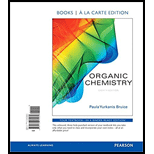
(a)
Interpretation:
Thermodynamically stable product compared with reactant in the given reaction has to be determined.
Concept introduction:
If
If
In an exergonic reaction the products have a lower free energy than it consumes.
In an endergonic reaction the product have a higher free energy than it consumes.
(b)
Interpretation:
Most kinetically stable product compared with reactant in the given reaction has to be determined.
Concept introduction:
Kinetic stability can be represented as
If
If
If
In an exergonic reaction the products have a lower free energy than it consumes.
In an endergonic reaction the product have a higher free energy than it consumes.
(c)
Interpretation:
Least kinetically stable product compared with reactant in the given reaction has to be determined.
Concept introduction:
Kinetic stability can be represented as
If
If
If
In an exergonic reaction the products have a lower free energy than it consumes.
In an endergonic reaction the product have a higher free energy than it consumes.
Want to see the full answer?
Check out a sample textbook solution
Chapter 5 Solutions
ORGANIC CHEMISTRY (LL)-W/MOD.MASTERING.
- Which reaction is faster, one with Eact = +41.8 kJ/mol or one with Eact = +20.9 kJ>mol? Explain.arrow_forwardDraw an energy diagram for each reaction. Label the axes, the starting material, product, transition state, ΔH°, and Ea. a. a concerted reaction with ΔH° = –80 kJ/mol and Ea = 16 kJ/mol b. a two-step reaction, A → B → C, in which the relative energy of the compounds is A < C < B, and the step A → B is rate-determiningarrow_forwardDraw an energy diagram for each reaction. Label the axes, the starting material, product, transition state, ?H°, and Ea.a. a concerted reaction with ?H° = –80 kJ/mol and Ea = 16 kJ/molb. a two-step reaction, A -> B ->C, in which the relative energy of the compounds is A < C < B, and the step A -> B is rate-determining.arrow_forward
- 1) Sketch an energy diagram that would show the following:A) An exothermic reaction that is thermodynamically favorable and would occur quickly.B) An exothermic reaction that is thermodynamically favorable and would not occur at a measureablerate.C) An endothermic reaction that is thermodynamically favorable and would occur quickly.arrow_forwardExplain the importance of Pericyclic Reactions? Why should we study ?arrow_forwardWhich reaction is fastest out of each pairarrow_forward
- Select the reactions in Figure 39 that can be represented by the accompanying energy diagram?arrow_forwardFor each reaction in question 20, sketch a reaction coordinate energy diagram indicating the starting materials, transition states and any intermediates, if present, in the reaction. Don't worry about the absolute energy of starting materials and products but you can assume that the product is more stable than the starting materials.arrow_forwardFill in the missing starting material, reagents, or product for each reactionarrow_forward
- Consider the energy diagram in Figure 6. Select the correct statements. * A- This reaction proceeds through a mechanism with three transition states. B- Step 1 determines the rate of the overall reaction. C- The first reactive intermediate is more stable than the second reactive intermediate. D- This reaction proceeds through a mechanism that has three elementary steps. E- The overall reaction is endothermicarrow_forwardConsider the following two-step reaction: a.How many bonds are broken and formed in Step [1]? Would you predict the ΔHo of Step [1] to be positive or negative? b.How many bonds are broken and formed in Step [2]? Would you predict the ΔHo of Step [2] to be positive or negative? c.Which step is rate-determining? d.Draw the structure for the transition state in both steps of the mechanism. e.If ΔHooverall is negative for this two-step reaction, draw an energy diagram illustrating all of the information in parts (a)–(d).arrow_forwardDoes the reaction in part b have multiple possible products? Do you know which one is more abundant?arrow_forward
 Organic Chemistry: A Guided InquiryChemistryISBN:9780618974122Author:Andrei StraumanisPublisher:Cengage Learning
Organic Chemistry: A Guided InquiryChemistryISBN:9780618974122Author:Andrei StraumanisPublisher:Cengage Learning
